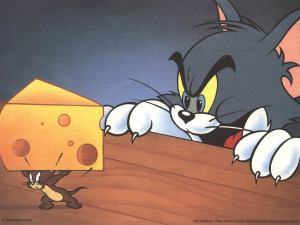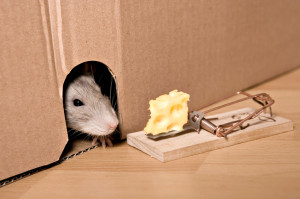 So, you have a mouse in your home, and you try to trap it with an old-fashioned (but still effective) mouse trap baited with cheese. It fails.
So, you have a mouse in your home, and you try to trap it with an old-fashioned (but still effective) mouse trap baited with cheese. It fails.
You just wasted a delicious piece of cheese, and the mouse trap didn’t yield any results. What went wrong?
What Do Mice Really like to Eat?
You may remember cartoons like Tom and Jerry from your childhood. The cat-and-mouse story is a very recognizable motif in media and especially in children’s cartoons and comics. The story usually goes like this: A curious cat spots a sly mouse on the hunt for a shiny, orange triangle of cheese, and a chase ensues. The cheese is the grand prize at the end of the story, and the mouse always manages to win this prize.
But do mice really like to eat cheese? If so, why did your mouse bait fail to bring the rodent out from hiding? And if not, why do cartoonists love to depict mice as cheese-loving little maniacs.
The Origins of Mice Eating Cheese
 As is described in Daven Hinsky’s article on this very subject, there are a few theories on why this image pops up in cartoons so often.
As is described in Daven Hinsky’s article on this very subject, there are a few theories on why this image pops up in cartoons so often.
Rodents have been a problem for families for thousands of years. Many people suggest that the western concept of a mouse with a piece of cheese probably arose from ancient texts. Ancient people did not have the wide variety of food sources as humans. They ate primarily preserved meats, grains, and… you guessed it. Cheese! When one of these people encountered a mouse, chances are the mouse was looking for or eating one of those three types of foods. So, it is possible that ancient people believed that mice like cheese and that idea may have lasted through the centuries.
There is also some evidence that the Greek God Apollo was sometimes called ‘Apollo Smintheus’ or Apollo the Mouse. As Hinsky describes in his article, Apollo’s child, Aristaeus, is described in Greek mythology as having taught the world how to produce cheese. Perhaps, early cartoonists used images from Greek Mythology for inspiration.
Maybe Artists just like Drawing Mice with Cheese!
Who can deny that a picture of a mouse with a piece of cheese isn’t a funny illustration? For centuries, painters have created still life depictions feasts with fruit, nuts, bread, wine and, of course, cheese. Adding a mouse to the image adds a playful touch.
What is the Best Bait for a Mouse Trap?
Do mice like cheese? The answer is that mice will eat just about anything, from foamy insulation to food from your pantry. That does include cheese, but cheese isn’t a mouse’s favorite food because mice don’t really have a favorite food. That said, they do like some foods more than others.
As it turns out, many species of mice in the Austin area seem to be attracted to sweets! Our customers have seen more success with foods like chocolate candy, peanut butter, or hazelnut spreads for mouse bait, rather than cheese.
Bread-based products also make good bait for mice. You might try a little leftover bread with some peanut butter on it to bait your trap.
A Few Pet-Safe Tips to keep in Mind
Take extra precautions with traps if you have pets in your home. If you have a natural mouse-hunter (a cat) in your home, we do not suggest using cheese as bait. Cats love dairy, and you may unintentionally injure your pet by setting a trap with cheese as bait. If you have a dog, the combination of chocolate and the trap itself could cause injury. Keep in mind that the best place for a trap to do its job is not out in the open. Try setting traps underneath counters, in cabinets underneath sinks, and under furniture. These areas are far enough out of reach for dogs and cats, and they’re good mouse hiding spots, too.
Mouse Traps not Working? You May have a Bigger Problem
Whether your traps are failing or you are finding more mice even after you’ve trapped one, it may be time to call an exterminator. Mice reproduce fast, so just one mouse could indicate an infestation.
Let the experts take care of your mouse problem. Learn more about Austin’s best rodent control specialists and schedule service with ABC today.
Schedule Service